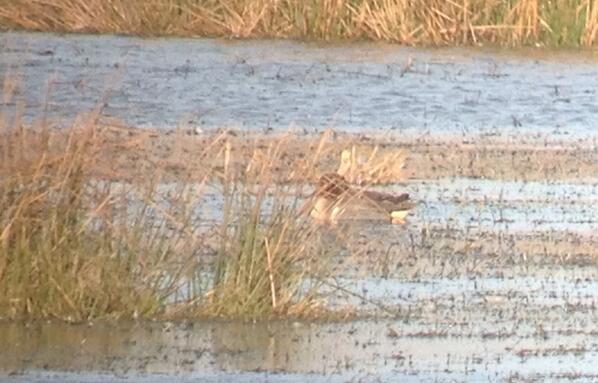I've got some really interesting news of a returning blackcap, but first a round-up of the weekend on the patch.
On Friday evening there, autumn wader passage was underway with a
greenshank and
ruff on the Budge fields, an
avocet and a single black-tailed godwit were also present and an adult little egret was feeding.
 |
| Adult little egret feeding on Budge fields |
A
grasshopper warbler was 'reeling' from the umbellifers on the dune-back opposite the path to the Budge screen - it was still reeling today from 5am to midday!
Offshore, there were at least five
roseate terns fishing, which isn't surprising given that there are over 100 pairs nesting on nearby Coquet Island. I also saw my first
Arctic skua of the year, harrying the terns.
 |
| Red admiral |
There are a lot more butterflies on the wing now that summer has arrived. Ringlet, small skipper, meadow brown, wall, red admiral, small tortoiseshell, speckled wood were all seen and,today, my first
dark-green fritillaries of the year.
As it rained for much of yesterday morning, I put my patch-visit off until the evening. On the edge of the patch, between Bell's farm and the plantation, I stopped to watch some
swift passage - a steady stream of these early migrants headed south. Whilst scanning them, a strikingly dark swallow flew past me. I watched it for while, it was male, but the underparts were much more chestnut/orange than any other barn swallow I've seen. It almost reminded me of the North American race, but it had a good, dark breast-band. It was certainly a striking bird, but I don't think it was anything other than a darker than average
rustica.
 |
| A 'bog-standard' swallow taking a feather to line it's nest |
On the Budge fields there were 28 black-tailed godwit and yesterdays ruff and a new ringed plover. A male
marsh harrier flew in and started hunting over the Budge field, scattering some duck and lapwings.
 |
| male marsh harrier hunting over the Budge fields |
Also of note were five large
shoveler youngsters. I've seen this on previous years at Druridge, where a female shoveler will turn up late in the summer with well-grown young. I am not sure if these birds were capable of flight, but they were nearing adult size, so they probably were.
Today, I got up early and put some nets up to ring birds. I didn't catch much, I presume a lot of the warblers are sat tight on second broods. I caught 14 new birds, all but two of which were juveniles. I would have expected to have caught more young warblers (I caught two backcaps and a chiffchaff), I think the prolonged cold spring and erratic storms may have done for some first broods.
Between net-rounds I had a scan from the dunes and picked up a small falcon flying west. I automatically assumed it would be a kestrel, but when I put my bins on it I was surprised to see a fine adult
hobby. It had a small bird of some species in its talons (maybe a sand martin, there were a lot of them), it continued west over the bushes and turned south with it's prey, maybe looking for somewhere suitable to deal with it?
So, to the story of the blackcap. I retrapped a female breeding blackcap today, which we ringed as a juvenile last year. This got me thinking about thinking about the blackcap that we ringed that ended up in France (read the story here
http://ipinswildlifeblog.blogspot.co.uk/2015/02/the-french-connection.html ) and whether it may have come back, so I checked our retraps for the year and it has!
Y540945 was ringed as a juvenile male on the 27th August by me and James Common, we caught it again on the 5th September. On 25th September it was caught by a ringer 1251km in Landes near Biarritz in France.
Looking at our retraps for this year I discovered that Y540945 has returned! I caught it on 9th June as breeding male. This is the first time we have ever had a long-distance migrant trapped elsewhere other than Druridge, return to our site. Isn't migration amazing!
130 greenshank
131 Arctic skua
132 hobby




































